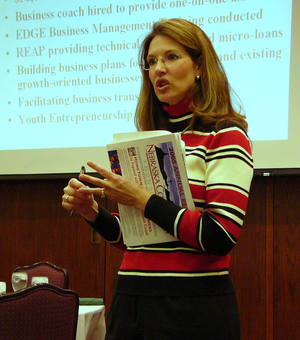HomeTown Competitiveness strategies outlined in Panhandle

Strategies that HomeTown Competitiveness has already used to help numerous rural communities throughout Nebraska were outlined Tuesday night to about 30 people who attended an informational meeting at Chadron State College. Jana Jensen of Bingham, an assistant development director for the Nebraska Community Foundation, said the program can help new businesses open and existing businesses expand, providing opportunities for youths to remain in their hometowns.
Jensen said HTC also has helped establish community foundations that have encouraged long-time members of the community to leave some of their wealth in their home communities.
Another phase of the program is leadership development. Jensen said without that, the other goals are difficult to attain.
While opening the meeting, Dr. Lois Veath, interim vice president of academic affairs at Chadron State, said the college has become a partner in HTC. She pointed out that CSC is closely tied to the economic health of the rural communities because as the population declines so does the college’s enrollment.
“This is a strategic plan to help us reinvent ourselves,” Veath said. “It can help us start businesses, expand existing businesses and provide opportunities for young people to remain in the region.”
The meeting in Chadron was one of four held in the Panhandle this week. The others were in Scottsbluff, Alliance and Sidney. They were to lay the groundwork for an HTC Academy at Chadron State on Sept. 12-14 that will put the program into action. It is hoped that a majority of the communities in the 11-county area will be represented.
HomeTown Competitiveness was founded four years ago by the Nebraska Community Foundation with assistance from the Center for Rural Entrepreneurship and the Heartland Center for Leadership Development, all non-profit organizations designed to strengthen rural Nebraska. A $2 million grant from the W.K. Kellogg Foundation gave the program a big shot in the arm.
Jensen said there is no magic formula or single solution for reversing the decline of rural communities, but that creating a more diverse economy to supplement production agriculture is a key component.
“Helping businesses expand and start up is one element,” Jensen said. “We also need to change the attitude that kids have to leave their hometowns in order to make a living. They already understand the environment and what it takes to make it in Nebraska. With today’s technology, there are many more ways to make a living in rural Nebraska.”
HTC began four years ago in Ord and has spread to 12 more Nebraska communities.
Jensen said some $20 million in new business investment has occurred and 68 new jobs have been created in Ord since the program took root there. In addition, four estates have contributed or designated for gifting $6.8 million to a community foundation that was created.
This past year, proceeds from the gifts allowed $65,000 to be used for special projects in Valley County, where Ord is located.
“There’s money in the hills of Nebraska,” Jensen said while distributing a sheet that indicated there will be a $258 billion transfer of wealth in Nebraska over the next 50 years as members of the older generation pass their fortunes to heirs. The figure for Dawes County is set at $956 million, or $19 million a year.
Jensen noted that just a few hours after many funerals in rural Nebraska there’s often a massive transfer of wealth. The money has been left to descendants who live in other parts of the country and is lost permanently. But with a community foundation available, residents will frequently leave at least a portion of their estate in the old hometown to assist with various program, she stated.
HomeTown Competitiveness also has arranged for the transfer of businesses that otherwise probably would have closed, set up a recruiting process that linked businesses seeking employees with people who were looking for new opportunities and provided leadership training.
Jensen said 70 residents of Ord have graduated from leadership classes there.
“Leadership is so important,” said Jensen. “If you don’t have basic leadership it won’t work.”
Also speaking Tuesday night was Darryl Birkenfeld of Nazareth, Tex., a Nebraska native who has directed two HTC seminars. He is executive director of Ogallala Commons, a loosely-knit organization of residents who live over the Ogallala Aquifer.
Veath, Jensen and Birkenfeld urged those in attendance to form a team of at least five members and return for the academy at CSC in September so HTC can begin operating in the Panhandle. They said it will be a plus if the two or three high school or college students from each community also participate.
Veath said at least a half dozen presenters, including some state officials, will lead the academy. “It will be an in-depth workshop and training session,” she noted.
The cost of the academy will be $500 per person, but Veath said the figure is two-thirds the normal charge because Chadron State is helping underwrite it. She added that CSC business faculty will provide technical assistance and business plan support following the academy.
Category: Campus News
